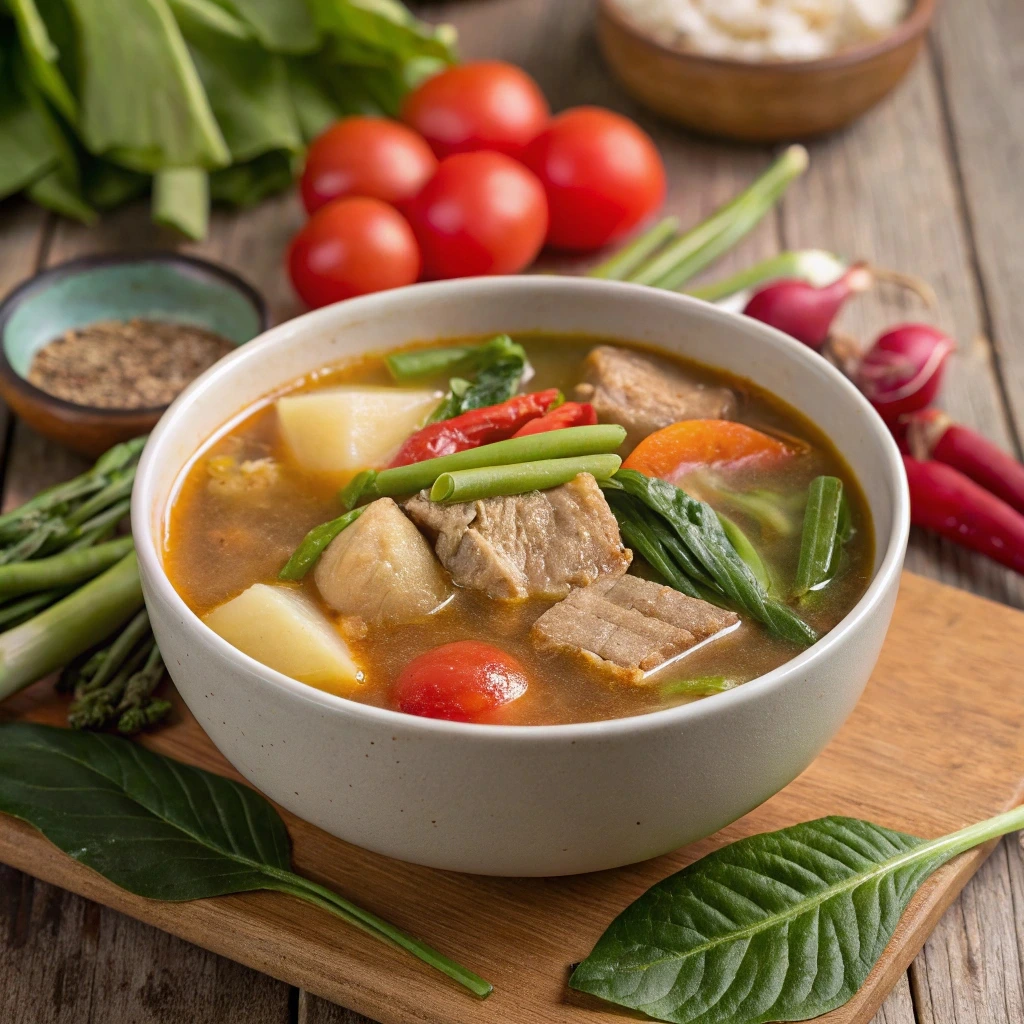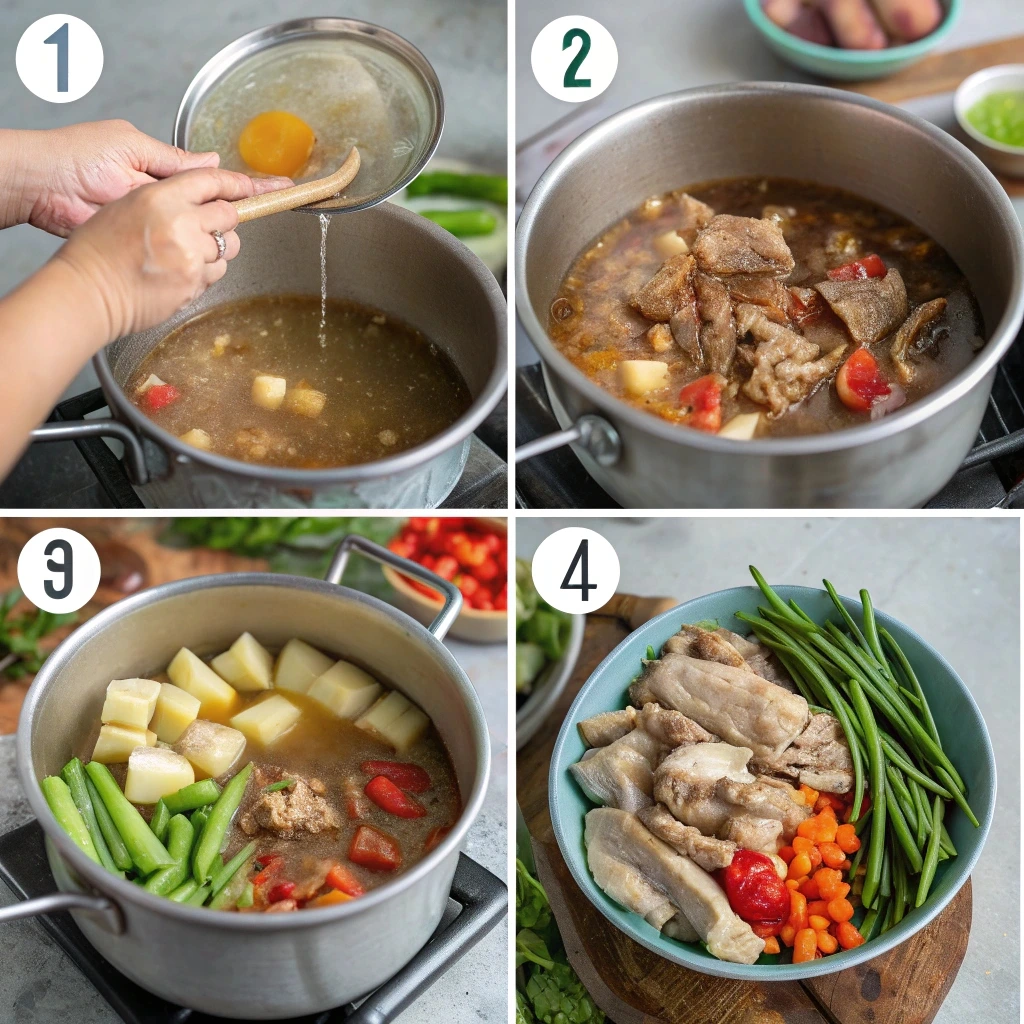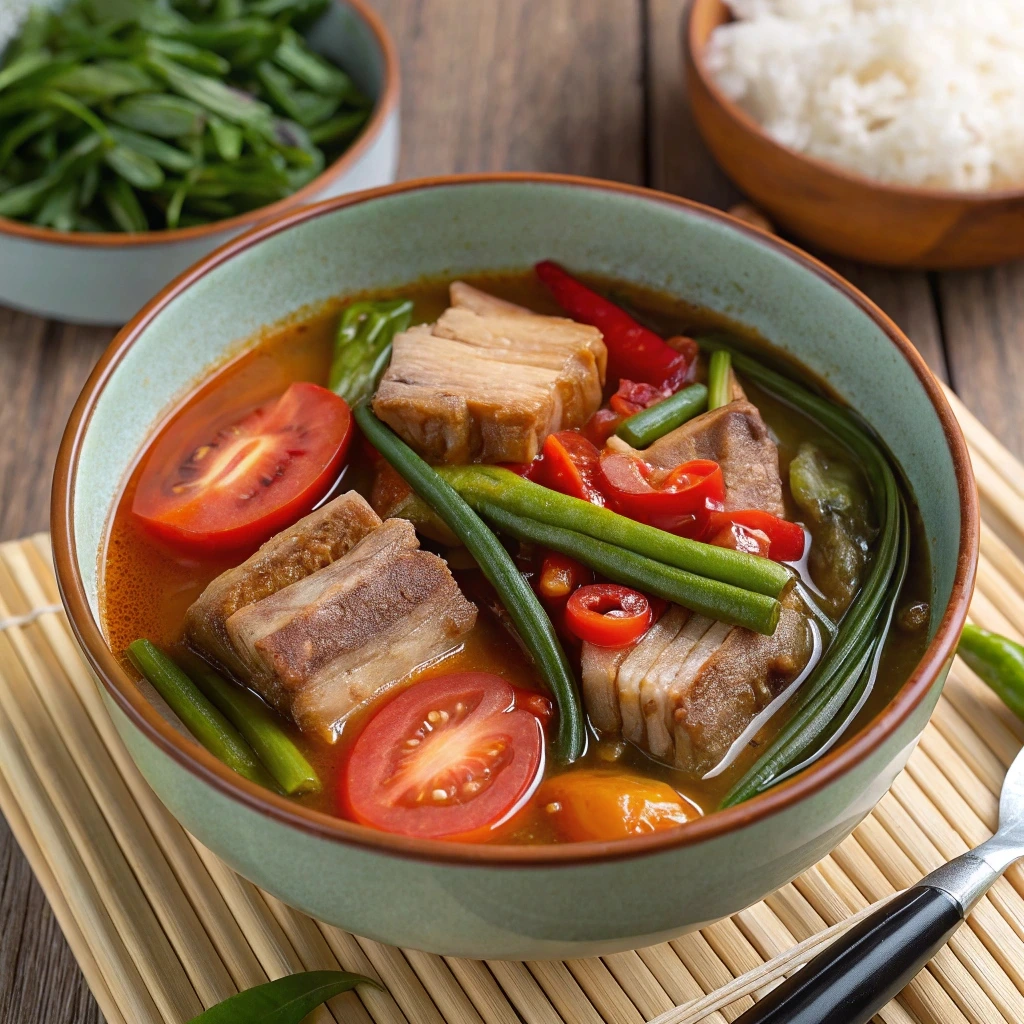Sinigang. Just saying the word makes your mouth water, right? This beloved Filipino sour soup has been warming hearts and bellies for generations. But there’s more to it than just tamarind and pork—behind this cozy comfort food lies a rich cultural story, a variety of ingredients, and countless ways to make it your own.
In this comprehensive guide, we’ll explore everything you need to know about crafting the perfect Sinigang Recipe. From the origin of the dish and the best cuts of meat to modern twists and alternative ingredients, we’ve got it all covered. Whether you’re a kitchen newbie or a seasoned home cook, this guide will help you whip up a bowl of sinigang that’s both authentic and delicious.
So grab your ladle, and let’s dive into the tangy, tasty world of sinigang!
Table of Contents
Introduction to Sinigang Recipe and Its Cultural Roots
What is Sinigang? A Taste of Filipino Heritage
Sinigang is more than just a soup—it’s a warm hug in a bowl. Known for its signature sour flavor, this iconic dish is a staple in Filipino households. It typically features a tangy broth made with tamarind, loaded with meat (usually pork), and a medley of vibrant veggies like kangkong, string beans, and eggplants. But hey, there’s no strict rule—you can swap the pork for shrimp, fish, or even beef, depending on your mood (or what’s in your fridge).
Why Sinigang Recipe is More Than Just a Soup
While adobo often gets the spotlight as the national dish, many Filipinos argue that sinigang deserves the crown. Why? Because it’s deeply personal. Each family has their own version, passed down through generations. Some like it extra sour, others prefer it mild and mellow. In fact, it’s not just a recipe—it’s a memory. It’s Sunday lunches, rainy day comforts, and that unmistakable aroma floating through grandma’s kitchen.
A Brief History and Cultural Significance
The term “sinigang” comes from the Tagalog verb “sigang,” meaning “to stew.” It’s a cooking method as much as it is a dish. Though no one knows exactly when it first appeared, sinigang’s roots go way back—long before instant mixes and rice cookers were a thing. Historically, Filipinos used native fruits like tamarind, kamias, and even guava to sour the broth.
And here’s a fun fact: in 2021, TasteAtlas crowned sinigang the best vegetable soup in the world! That’s right. Our humble bowl of sinigang na baboy beat out global contenders for its bold, comforting, and refreshing taste.
Sinigang Recipe vs. Other Filipino Dishes: A Flavorful Comparison
Now, don’t get us wrong—we love adobo, lechon, and kare-kare. But sinigang is in a league of its own. While others lean on savory or sweet notes, sinigang stands out with its lip-smacking sourness. It’s a flavor explosion that balances the richness of meat with the zing of tamarind or other fruits. Moreover, it’s one of the few Filipino dishes that genuinely changes from household to household, region to region. In short, it’s flexible, it’s comforting, and it’s 100% Filipino.

Choosing the Right Protein for Your Sinigang Recipe
Popular Protein Options: Pork, Beef, Shrimp, and Fish
Let’s face it—when it comes to Sinigang Recipe success, the protein makes or breaks the dish. Traditionally, pork is the go-to choice, especially fatty cuts like pork belly. Why? Because the fat adds richness to the broth and gives it that melt-in-your-mouth bite.
However, that doesn’t mean you’re stuck with just pork. In fact, many Filipino households switch things up depending on availability. For example, beef sinigang is equally hearty and pairs beautifully with the sour broth. On the lighter side, sinigang na hipon (shrimp sinigang) brings a fresh, ocean-like flavor that’s perfect for summer days.
Meanwhile, fish—like bangus (milkfish) or tilapia—offers a delicate twist for those who prefer something leaner. And if you’re cutting back on red meat, chicken works surprisingly well too!
Why Pork Belly Remains a Favorite Choice
Sure, there are lots of protein options, but pork belly still reigns supreme. Why? Because it checks all the boxes: flavor, fat, and tenderness. The natural oils from pork belly enrich the soup, making every spoonful unforgettable. Moreover, the meat becomes so soft after simmering, it practically falls apart.
Here’s a quick look at the most popular protein choices for Sinigang Recipe:
| Protein Option | Why It Works |
|---|---|
| Pork Belly | Rich, fatty, tender—perfect for bold flavors |
| Pork Shoulder/Spare Ribs | Cheaper, still flavorful, and falls off the bone |
| Beef (Brisket/Short Rib) | Hearty, meaty, great for slow simmering |
| Shrimp | Light, sweet, balances the sour broth |
| Bangus or Tilapia | Mild flavor, great for a healthier twist |
| Chicken Thighs | Lean yet flavorful, especially with tamarind |
Therefore, while there are many variations, choosing the right protein sets the tone for your dish. Pick one that matches your mood—and your pantry.
The Heart of Sinigang Recipe – Souring Agents Explained
Traditional Souring Ingredients: Tamarind, Kamias, Guava
At the core of any Sinigang Recipe is the souring agent. Without it, well—it’s just soup. The most common ingredient used in traditional Sinigang Recipe is tamarind (sampalok). It gives the broth that signature sharp, tangy taste Filipinos love.
However, regional and seasonal variations have brought in other ingredients too. Kamias (bilimbi) is another classic that adds a clean, citrus-like sourness. Meanwhile, guava lends a milder, slightly sweet flavor that gives the broth a unique depth. Moreover, green mango and even cotton fruit (santol) are used in provinces, depending on what’s available.
Modern Alternatives: Sinigang Recipe Mix and Tamarind Paste
Let’s be real—not everyone has fresh tamarind lying around. That’s where store-bought Sinigang Recipe mix or tamarind paste comes in handy. These options are convenient and still pack a punch. Plus, they allow you to adjust the sourness with just a few teaspoons.
But if you’ve got the time (and patience), using fresh tamarind really elevates the flavor. Just boil it in water, mash it, and strain it into your pot. Trust me—your tastebuds will thank you!
Here’s a breakdown of common souring agents and what they bring to your Sinigang Recipe:
| Souring Agent | Flavor Profile | Best For |
|---|---|---|
| Fresh Tamarind | Bold, tangy, rich | Classic pork or beef sinigang |
| Sinigang Mix (powder) | Convenient, tangy, balanced | Busy cooks, everyday sinigang |
| Tamarind Paste | Concentrated, slightly sweet | Quick version of any sinigang |
| Kamias (Bilimbi) | Citrus-like, very sour | Seafood sinigang |
| Green Mango | Sharp and tart, fruity | Regional twists |
| Guava | Mellow, slightly sweet and floral | Guava sinigang (milder broth) |
| Santol (Cotton Fruit) | Sour, with a tropical kick | Southern Filipino versions |
| Pineapple | Sweet and sour, tropical | Creative or fusion sinigang |
As a result, your choice of souring agent doesn’t just shape the taste—it shapes the entire identity of your sinigang.
Ingredients List for the Classic Pork Sinigang Recipe
Main Ingredients and Their Functions
Let’s roll up our sleeves! It’s time to gather the essentials for a classic Sinigang Recipe. This version uses pork belly and tamarind for that deep, hearty flavor we all crave. However, feel free to tweak it based on what’s in your pantry or what’s fresh at the market.

Most of these ingredients are easy to find at Asian groceries or even your local supermarket. Plus, once you’ve tried this dish, you’ll probably keep these items stocked all the time!
Here’s your go-to table for prepping ingredients:
| Ingredient | Quantity | Purpose |
|---|---|---|
| Pork Belly | 2 lbs (cut into chunks) | Adds richness and tenderness |
| Young Tamarind | 1 lb | Main souring agent for authentic tang |
| Water Spinach (Kangkong) | 1 bunch (chopped) | Adds freshness and slight bitterness |
| String Beans (Sitaw) | 8 pieces (2-inch cuts) | Provides crunch and fiber |
| Eggplants | 2 pieces (sliced) | Soaks up flavor and adds texture |
| Daikon Radish (optional) | 1 piece (sliced) | Enhances broth with a subtle earthy flavor |
| Tomatoes | 2 pieces (quartered) | Adds body and a natural sweet-sour element |
| Onion | 1 piece (quartered) | Deepens the flavor of the soup base |
| Long Green Peppers | 2 pieces | Mild spice and aroma |
| Okra | 8 pieces | Softens the texture and slightly thickens broth |
| Fish Sauce | To taste (about 1 tbsp) | For that umami Filipino kick |
| Ground Black Pepper | To taste | Optional, for a gentle spice boost |
| Water | 2 quarts | The soul of the soup |
Pro Tip: If you’re pressed for time, you can replace fresh tamarind with a good quality sinigang mix. It may not be traditional, but it works wonders on busy weeknights!
For more delicious recipes like this, check out our Easy Homemade Beefaroni Recipe — it’s another comforting dish you can whip up in no time!
Step-by-Step Guide to Cooking Sinigang Recipe

Step 1: Extracting the Tamarind Broth
First things first, let’s get that sour base ready. If you’re going the traditional route, boil your young tamarind in 2 quarts of water for about 40 minutes. This draws out all the tangy goodness. After boiling, strain the mixture using a sieve or cheesecloth. Don’t forget to squeeze the pulp — there’s still tons of flavor in there.
However, if you’re short on time, tamarind paste or a sinigang mix can be used instead. Just dissolve it directly into boiling water and adjust the amount to your desired sourness.
Step 2: Cooking the Pork to Tender Perfection
Next, pour the tamarind broth into a deep cooking pot. Bring it to a boil and toss in the onion and half of the tomatoes. These form the base of your soup.
Add the pork belly pieces and let them cook until tender — about 45 to 90 minutes depending on your meat cut. Skim off any scum that floats to the top for a cleaner broth. Then, season with fish sauce and a bit of ground black pepper if desired.
Pro Tip: Cover your pot to lock in heat and flavor while simmering.
Step 3: Adding Vegetables in Stages for Texture
Not all veggies are created equal—especially when it comes to cooking time. Add the firm ones first, like radish and eggplant. Let them simmer for 5 minutes.
Then toss in the okra, string beans, remaining tomatoes, and green chili peppers. These just need about 3 more minutes.
Finally, throw in the water spinach stalks. Let them simmer for 2 minutes before turning off the heat. Add the leafy tops last and cover the pot. They’ll cook perfectly in the residual heat.
Step 4: Final Seasoning and Simmering Techniques
Now that all the ingredients are in, taste the broth. Does it need a splash more fish sauce? Maybe a bit more sourness? Adjust accordingly. The best Sinigang Recipe is the one that suits your taste buds.
Once everything’s well-balanced, let the pot rest for about 3–5 minutes before serving. This allows the flavors to meld beautifully.
And there you go — a warm, sour, and comforting bowl of sinigang ready to impress!
Sinigang Recipe Variations You Must Try
Sinigang sa Miso: A Japanese Twist
If you’re in the mood for something different, try Sinigang sa Miso. This version blends the familiar sour tamarind broth with fermented soybean paste, giving it a richer, umami-packed flavor. It’s a favorite in some regions of the Philippines and pairs especially well with bangus (milkfish) or salmon.
Miso brings a creamy depth that balances beautifully with the soup’s natural tang. Moreover, it adds a slightly salty, savory layer that keeps you coming back for more. For best results, dissolve the miso into the hot broth toward the end of cooking—this keeps its flavor from fading during the boil.
Sinigang na Hipon, Kamias, Guava, and More
Shrimp sinigang, or sinigang na hipon, is another hit, especially when you want something quick and light. Shrimp cooks fast, so you can have a hearty meal in under 30 minutes. Add the shrimp last to avoid overcooking—it only takes about 5 minutes to become tender and juicy.
Alternatively, you can get creative with the souring agents. Swap tamarind for kamias, guava, green mango, or even pineapple if you’re after a fruitier profile. Each brings its own twist, making your Sinigang Recipe a little more adventurous.
Want a chicken version? Try sinampalukang manok, where chicken simmers in tamarind leaves and ginger. It’s lighter, slightly herbal, and super comforting on rainy days.
As you can see, sinigang is endlessly customizable. Therefore, don’t be afraid to experiment—you might just discover your new favorite!
Serving Suggestions and Side Dishes
The Ideal Rice Pairing
Let’s be honest—sinigang without rice is like adobo without garlic. It just doesn’t feel right. A hot bowl of sinigang, poured over a plate of steamed white rice, is a match made in foodie heaven. The rice helps mellow the sourness and absorbs all that flavorful broth.
However, you can also pair it with garlic rice if you’re feeling extra. The garlic’s bold kick plays well with the soup’s tangy notes.
Best Side Dishes: Tuyo, Fried Fish, and More
To complete the experience, add a side dish that contrasts or enhances the sinigang’s flavor. Tuyo (dried salted fish), for example, is a classic Filipino companion. It’s salty, crispy, and complements the soup perfectly.
Fried bangus or even grilled tilapia also work wonders. Their crispy skin and flaky meat create a lovely balance with the soft, juicy pork or shrimp in your Sinigang Recipe.
You can also serve a small bowl of patis (fish sauce) with chopped chili as dipping sauce—it brings out more flavor and spice.
For more creative mealtime ideas, don’t forget to check out other Filipino-inspired comfort foods on our site. Each dish adds something special to your culinary table.
Tips and Tricks for Beginners and Busy Cooks
Slow Cooker and Instant Pot Hacks
Cooking sinigang doesn’t have to eat up your whole afternoon. In fact, using a slow cooker or Instant Pot can save you a lot of time—without sacrificing flavor. If you’re using an Instant Pot, simply sauté your aromatics (onions and tomatoes), then add your pork and tamarind broth. Pressure cook for about 35 minutes. Afterward, toss in your veggies and let the residual heat cook them just right.
For slow cookers, prep everything in the morning. Let it simmer on low for 6 to 8 hours. That way, you’ll come home to a pot full of tender meat and rich broth, ready to serve.
What to Do If You’re Missing Ingredients
No daikon radish? No problem. No kangkong? Use spinach or even bok choy. The beauty of a great Sinigang Recipe lies in its flexibility. Moreover, if you can’t find fresh tamarind, a sinigang mix or tamarind paste will work just fine.
Busy night? Just use pre-cut pork and frozen vegetables. Therefore, you’ll get a warm, homemade Filipino dish in less time, but with all the comfort you crave.
Health Benefits of Sinigang Ingredients
Why Sinigang Can Be a Nutritious Meal
Besides being delicious, sinigang is also packed with nutrients. For starters, the vegetables used in most Sinigang Recipe versions—like string beans, water spinach, and eggplant—are full of fiber, vitamins, and antioxidants. These help improve digestion, boost immunity, and even lower cholesterol.
Moreover, the tamarind used as the souring agent is rich in vitamin C and polyphenols. It may help reduce inflammation and support heart health.
Balanced Flavor, Balanced Diet
Let’s not forget the protein. Whether you choose pork, shrimp, or fish, the protein helps repair tissues and build muscle. However, if you’re watching your fat intake, consider using leaner cuts of pork or switching to fish or shrimp.
In addition, because the broth is water-based and not oil-heavy, sinigang is generally low in calories. Just go easy on the rice if you’re counting carbs.
In the end, a bowl of sinigang isn’t just comforting—it’s wholesome, too.

Frequently Asked Questions (FAQs)
What Makes Sinigang Sour?
The signature sour taste in any Sinigang Recipe typically comes from tamarind. However, some versions use kamias, green mango, santol, or even guava. Each gives a slightly different sour kick.
Can I Use Lemon Instead of Tamarind?
Yes, you can! Lemon is a decent substitute if you’re in a pinch. It won’t have the same depth as tamarind, but it does offer a similar acidity. Just add it gradually and taste as you go.
How Do I Make Sinigang Less Sour?
If you went a little overboard with the souring agent, don’t worry. You can balance it out by adding more water, a bit of sugar, or more vegetables like tomatoes or radish.
Is Sinigang the National Dish of the Philippines?
Officially, no—adobo holds that title. But ask around, and you’ll find that many Filipinos consider sinigang their favorite. Its sour, savory profile is unique and comforting in ways that go beyond a typical meal.
Can I Freeze Leftover Sinigang?
Absolutely. Just store it in an airtight container. It keeps well for up to 3 months in the freezer. Reheat gently to avoid overcooking the vegetables.
How to Cook Sinigang in an Instant Pot?
Use the sauté mode to brown your aromatics and meat. Then switch to pressure cook for 30–35 minutes. Finally, add your veggies, and let them sit in the hot broth until cooked through.

